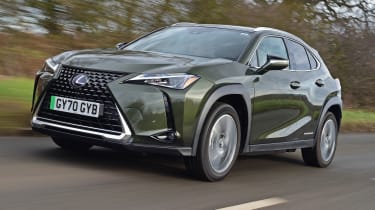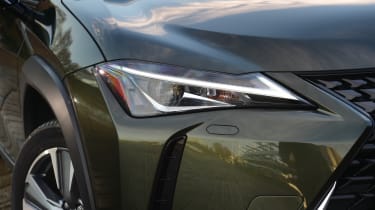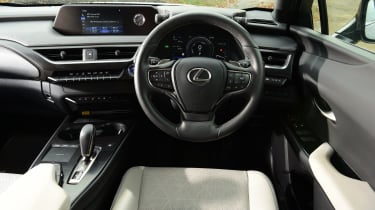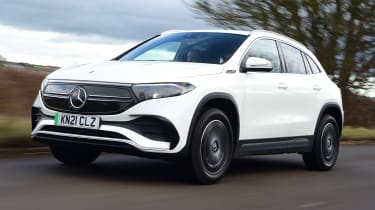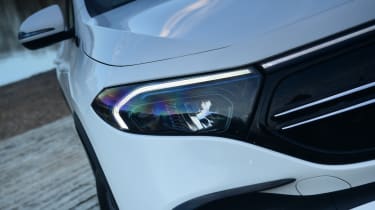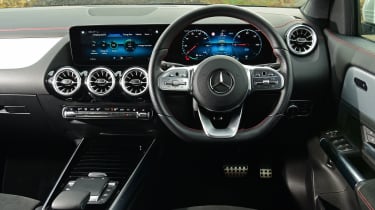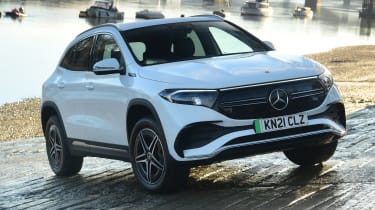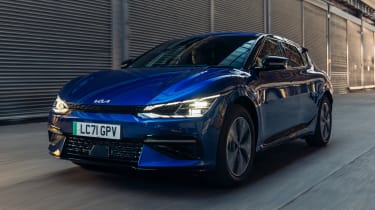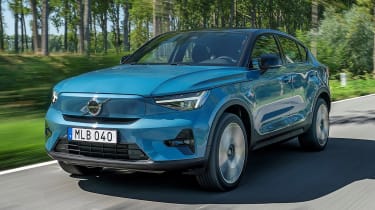Lexus UX 300e vs Mercedes EQA: 2022 twin test review
Compact premium electric SUVs from Mercedes and Lexus go head-to-head
There’s a relentless wave of large electric SUVs joining the top end of the new-car market, but it’s the offerings on a smaller scale that, for most buyers, will be more relevant. Compact EVs that suit urban areas – places where zero tailpipe emissions are most beneficial – are the type of battery-powered cars a bigger group of new-car buyers will be arguably more excited about.
That’s not to say that they should be limited purely to inner-city duties, though. These cars also need to have both the range and the usability to provide few headaches for those who need to embark on the occasional long motorway slog, too.
On paper, the two compact SUVs we’re testing here should be able to do exactly that. With its first battery-only model, Lexus appears to have the right idea. The UX 300e is the smallest SUV the brand offers – related to the hybrid-powered UX 250h. From the outside, it seems to have ideal proportions for a family-sized EV.
Mercedes has a much larger range of fully electric vehicles, and the EQA is its most modest offering, but it follows a very similar formula to the Lexus. So which of these premium crossovers is best?
Lexus UX300e
|
Model: |
Lexus UX 300e Premium Plus |
|
Price: |
£46,145 |
|
Powertrain: |
1x e-motor, 54.3kWh battery, 201bhp |
|
0-62mph: |
8.9 seconds |
|
Test economy: |
3.6mi/kWh |
|
CO2: |
0g/km |
|
Annual road tax: |
£0 |
Here, we’re testing the UX 300e in Premium Plus trim, which is in the middle of a three- strong trim line-up. It’s priced at £46,145, with our car’s optional Terrane Khaki paint bumping that figure up by £570, to £46,715.
Used - available now

2020 Land Rover
Discovery Sport
24,114 milesAutomaticDiesel2.0L
Cash £25,960
2023 Tesla
New Model Y
20,490 milesAutomaticElectric
Cash £26,697
2021 Audi
Q3
55,755 milesAutomaticPetrol2.0L
Cash £20,197
2020 Jeep
Compass
70,901 milesManualDiesel1.6L
Cash £11,197Design & engineering
There’s not much to set the all-electric UX 300e apart from the hybrid UX 250h on the outside. The keenest of eyes will spot a gently tweaked grille, which sits within a sleeker front bumper with smaller air intakes. Otherwise, it’s only the badges and wheels that provide much in the way of differentiation.
Under the skin, however, the adaptation to a zero-emissions powertrain has been extensive. Moving to electric drive means more weight has been added, and to compensate, the electric UX gets extra chassis bracing and a retuned suspension set-up when compared with its hybrid counterpart.
The extra engineering doesn’t stop there. It gets more soundproofing material, too, which is to reduce the effects of wind and tyre noise, both of which, Lexus says, become more noticeable once the combustion engine is taken out of the equation.
The UX 300e’s 54.3kWh lithium-ion battery feeds an electric motor on the front axle. The drivetrain develops 201bhp and 300Nm of torque, which is enough for a 0-62mph time of 7.5 seconds, while top speed is 100mph. Official WLTP testing figures state that the UX 300e will cover 186 miles on a charge.
Inside, the all-electric UX 300e is the same as the hybrid model, with the exception of a new automatic gear selector and some EV-specific displays for the SUV’s digital instruments and infotainment system. The driving environment feels a little more snug than it does in the Mercedes, but the level of fit and finish is excellent.
Driving
First impressions of the UX 300e on the road are very encouraging. The well weighted steering is immediately obvious; not only does it make the UX easy to place around town, but on the road it also allows you to make the most of the car’s agile chassis. It’s an exaggeration to suggest that it’s fun to drive, but by small electric SUV standards, it does a better job than most, including the EQA.
Agile handling sometimes comes at the expense of ride comfort, but that isn’t the case here. The UX 300e is pretty impressive at ironing out bumps, and the 17-inch wheels fitted with tyres that have a decent amount of sidewall manage to filter out broken tarmac well. The Lexus is more comfortable than the Mercedes, especially at low speeds.
Its electric motor is the punchier of the pair, too. The UX sprints off the line with real enthusiasm, and its 300Nm of torque is more than enough to overcome the front tyres’ grip if you’re not careful; the traction control will rather clumsily cut the power to keep things in check. Acceleration still remains fairly keen at motorway speeds, too.
If there’s one area where the Lexus needs some improvement, it’s under braking. The transition between deceleration from energy recovery through the electric motor to the mechanical braking system isn’t as polished as in the Mercedes. The mechanical brakes are quite grabby, too, making it difficult to bring the car to a smooth stop.
Practicality
The hybrid version of the UX is let down by a small boot, but this electric version fares better. At 367 litres, its volume is fine; indeed it beats the 340 litres in the Mercedes. Space in the electric EQA isn’t as strong as in its combustion-engined siblings.
The UX’s boot is reasonably well thought-out, with features such as a dedicated cubby beneath the boot floor that swallows the charging cable.The EQA has some underfloor storage too, but the space is too shallow for fitting any cables.
The back of the UX is very cramped. In order to accommodate their battery packs, both of these cars have a raised cabin floor. While it’s not ideal in the EQA, the level is so high in the UX that anyone above average height will find that their feet are pushed right up, meaning that the seat bases provide no under-thigh support. It’s not much better in other aspects either – knee and foot room are poor and headroom isn’t great, either.
Ownership
One area where Lexus consistently excels is the ownership experience that it provides for its customers. The plaudits go to the dealers in our latest Driver Power satisfaction survey; the network finished second only to Porsche out of 21 manufacturers covered.
As a brand, it took 10th overall out of 29 – still an above-average score. Reliability proved to be a strong point, too, with fewer than 10 per cent of owners reporting any faults across the entire Lexus range – one of the lowest figures of any manufacturer.
Mercedes was just above average in both categories; its dealers were ranked ninth overall, and as a brand it finished just behind Lexus in 13th.
Running costs
For the 2022 financial year, the Benefit-in-Kind rate for electric vehicles rises from one to two per cent – effectively doubling the cost. However, they’re still incredibly cheap relative to petrol or diesel SUVs of a similar price.
A higher-rate income taxpayer will face annual deductions of £368 for the Lexus and £392 for the Mercedes – that slightly larger number is a result of the EQA’s greater P11D value, but both cars cost thousands less than equivalent combustion vehicles.
For private buyers, both of these cars depreciate at a very similar rate. The Mercedes just edges ahead, holding 53 per cent of its value over three years, whereas its rival’s figure is 52.1 per cent.
Testers’ notes: “The lid of the UX’s centre armrest bin has a double hinge that means it opens in either direction, making it easily accessible for either front-seat occupant.”
Mercedes EQA
|
Model: |
Mercedes EQA 250 AMG Line |
|
Price: |
£48,150 |
|
Powertrain: |
1x e-motor, 66.5kWh battery, 187bhp |
|
0-62mph: |
7.5 seconds |
|
Test economy: |
3.3mi/kWh |
|
CO2: |
0g/km |
|
Annual road tax: |
£0 |
The EQA is the entry point to Mercedes’ ever-growing range of EVs, which includes four SUVs, two saloons and a van-based MPV. The EQA 250 AMG Line tested here is priced from £48,150, while adding the £1,495 Driver Assistance Package brings the total to £49,645.
Design & engineering
Much like the Lexus, the EQA doesn’t use a bespoke electric-vehicle platform. Instead, its architecture is adapted from existing combustion technology – in this case Mercedes’ small SUV, the GLA.
Unlike the Lexus, however, Mercedes offers the EQA with three powertrain options, each with different performance and ranges. The EQA 250 here is the entry point; its single-motor set-up offers 187bhp – 14bhp less than the Lexus. However, maximum torque of 375Nm is 75Nm up on its rival.
Above this model sit the EQA 300 and 350. These add an extra motor to the rear axle, so they provide four-wheel drive, with the EQA 300 making 225bhp and the EQA 350 offering 288bhp and 520Nm of torque – enough for a 0-62mph time of six seconds. Both of these models have the same 66.5kWh battery pack as the EQA 250, although the pair’s extra shove has done little to harm their range: the EQA 250 offers the most from a full charge, however, at 262 miles.
That battery is split in three, with one part beneath the back seats where the fuel tank sits in the GLA, while the other two are either side of the central tunnel beneath the cabin.
The interior will be largely familiar to GLA drivers, with a near-identical dashboard design. The only clear difference comes on the digital driver’s display, which shows an energy readout instead of a rev counter. The design itself looks a little more extravagant than the Lexus’s; you might have a preference, but both offer quality that’s worth their respective asking prices.
Driving
Weighing in at just over two tonnes, the EQA is no lightweight – something that becomes clear out on the road. It’s slower and more lethargic than the Lexus, both in terms of the way it turns into corners, and also in its keenness to move away from a standstill.
Engaging Sport mode does make it feel more alert, but the difference in claimed 0-62mph times – 7.5 seconds for the Lexus and 8.9 for the Mercedes – feels entirely believable.
On top of that, the Lexus is also the more refined car. The main difference is road noise – something that Lexus’s engineers have worked hard to iron out, and something which is quite pronounced in the Mercedes. The EQA’s ride can be a little bouncy, too.
There are other areas where the Mercedes feels more accomplished, though. While it lacks the UX’s agility, the trade-off is that at motorway speeds, stability is excellent; where the Lexus requires regular corrections, the Mercedes holds a solid course. There’s plenty of grip too, so while it isn’t particularly fun, it is safe and predictable.
While the EQA’s acceleration doesn’t feel as keen, the throttle is much easier to modulate here than in its rival, so it’s very satisfying to manoeuvre in the sort of low-speed environments that these cars are suited to. While the EQA’s mass can be felt during heavy braking, the overall feel is a little more consistent than the Lexus.
Paddles behind the wheel adjust the level of brake regeneration, while an auto mode can dictate how much deceleration is provided based on traffic and road conditions. We found it a little unpredictable, and preferred to manually override this setting.
Practicality
Although the Mercedes isn’t quite as generous as the Lexus for boot space, it’s much more pleasant for rear-seat passengers. While the UX feels no more accommodating than many superminis, the EQA is far more spacious – especially in terms of knee and headroom. Even though the floor is a little high, there’s still just about enough space for feet beneath the front seat – something that isn’t possible in the Lexus.
Rear-seat passengers can charge a mobile device thanks to a single USB-C port, while the rear armrest has a couple of pop-out cup-holders, too. The front door bins are larger than the UX’s, and even though the EQA’s rear bins are oddly shaped, there’s still just enough room for a small bottle.
Ownership
Both the EQA and UX were tested by Euro NCAP in 2019, and both bagged five-star ratings. The EQA just pipped the UX for adult and child occupant safety scores, while the Lexus was slightly better in the vulnerable road users and safety assist categories. It’s worth noting that the UX tested was the hybrid model rather than the EV, but the pair are fundamentally identical.
When it comes to warranty cover, Lexus is one of the best around. As long as you stick to the service schedules and go to a main dealer to get the work done, the UX is covered for up to 10 years. The EQA’s cover lasts for only three, but the mileage is unlimited over that period.
Running costs
During our time on the road, the Mercedes proved to be the more efficient of the two cars. We averaged 3.6 miles per kWh, which beat the Lexus and its figure of 3.3mi/kWh. Based on home charging at a rate of 28p per kilowatt hour, that translates to a cost of £1,556 over 20,000 miles for the Mercedes and £1,697 for the Lexus.
It’s worth noting that those energy consumption figures were achieved in fairly cool temperatures; we’d expect both to be better in the summer. Our returns translate into real-world ranges of 239 miles for the Mercedes and 179 miles for the Lexus.
Testers’ notes: “The Mercedes Me smartphone app lets you check the EQA’s charging status from your mobile, and even allows you to pre-heat or cool the cabin.”
Verdict
First place: Mercedes EQA
The EQA is one of our favourite compact EVs, and comfortably holds off the Lexus here, because it’s the better option for charging, range and in-car tech. It’s more efficient, which makes it cheaper to run, while the cabin is much more spacious in the back. It’s not as sharp to drive nor quite as refined as its rival, but they’re only minor complaints for an otherwise very accomplished EV.
Second place: Lexus UX 300e
With its first EV, Lexus has produced a mixed bag. In some areas, it’s brilliant; the cabin quality is at least a match for the Mercedes, and it’s more fun to drive while being quieter and every bit as comfortable. However, it’s compromised in other areas. The rear seats are cramped and the infotainment is poor. It can’t match either the range or charging speed of its rival, either.
Four alternative electric SUVs
- Model: S line 40 e-tron
- Price: £48,915
- Powertrain: 1x e-motor, 82kWh battery, 201bhp
Audi’s sharply styled SUV uses the VW Group’s MEB underpinnings, so in several ways the Q4 e-tron holds an edge over its rivals here. It comes with a potent 201bhp electric motor, and an 82kWh battery good enough for an official range that, in some trims, exceeds 300 miles. Rapid charging of up to 150kW is offered, too.
The key benefit to the Q4 e-tron, however, is space. The back seats are roomy, and the rear bench is taller, so it feels much more comfortable. There’s more elbow room, too, while the boot has a capacity of 520 litres.
Audi has tuned its EV to deliver a relaxing drive. The ride is softer than in either the Lexus or Mercedes, and combined with excellent refinement (and that range) it’s a great long-distance cruiser. There’s not much in the way of feedback through the steering, but the wheel itself looks like it could have been lifted from a concept car, lending the Q4 a futuristic feel that its rivals here can’t match.
- Model: GT Line
- Price: £45,595
- Powertrain: 1x e-motor, 77.4kWh battery, 226bhp
While the smaller Soul EV is better suited to an urban environment, Kia’s best electric tech is reserved for the EV6. Mechanically it’s very similar to the Ioniq 5; the basic E-GMP architecture is the same.
The powertrain options differ slightly, though. There’s a single rear-motor variant with 226bhp, or a twin-motor model with 321bhp and 605Nm of torque, which is enough to return a hot hatch-bothering 0-62mph time of 5.2 seconds.
There are other differences under the skin, too. A long 2.9-metre wheelbase contributes to a stable gait that makes the EV6 a great motorway companion, but the Kia’s suspension is stiffer than the Ioniq 5’s, too. While passengers will notice some extra firmness, the driver will enjoy a slightly sharper feel on twisty roads.
For many, the choice between EV6 and Ioniq 5 will come down to design. Both look like they’ve been beamed in from the future, but in place of the Ioniq 5’s 8-bit lights and sharp creases, the Kia is sleek and smooth. Inside, both are incredibly roomy, but the EV6’s environment feels a little more sporty.
- Model: Ultimate
- Price: £46,090
- Powertrain: 1x e-motor, 73kWh battery, 214bhp
If you can spare a little extra space on your driveway, then the Hyundai Ioniq 5 should be on any EV buyer’s shortlist. It’s 202mm longer and 41mm wider than the EQA, but step inside and it’s clear that Hyundai has made brilliant use of that extra footprint.
The packaging is fantastic, and you’ll struggle to find more legroom in anything this side of a BMW 7 Series. The boot is quite shallow, but at 527 litres it’s well beyond either the Mercedes or Lexus.
That accommodation is just one benefit of the Ioniq 5’s EV-specific platform. It also features an 800-volt electrical system, so it’s possible to charge from 10 to 80 per cent in just 18 minutes.
On the performance side, the Ioniq 5 is available with two powertrains – a 168bhp model with a 58kWh battery, or a 214bhp version with a 73kWh unit. The latter can cover up to 298 miles between top-ups, yet accelerates from 0-62mph in 7.4 seconds. Refinement and comfort are both strong points, as is standard kit.
- Model: Recharge Core
- Price: £45,750
- Powertrain: 1x e-motor, 69kWh battery, 227bhp
The XC40 is one of the biggest sellers in the premium SUV segment, and there’s no doubt that it has benefitted from the option of a fully electric model. In many ways the battery-only model is the pick of the range; it’s the quietest version on the move, while the linear torque delivery makes it far smoother than the petrol models to drive around town.
This funkily styled SUV benefits from Volvo’s brilliant safety record, too, while eco-conscious buyers can choose the option of recycled and non-leather fabrics inside. To top it all off, there’s a responsive Google-based infotainment system, too.
It’s not just the touchscreen that is rapid, either. In twin-motor specification, it gets 402bhp and a 4.9-second 0-62mph time, earning the XC40 genuine Q-car status. In reality, it’s more performance than anyone needs from a car like this, though, so we’d recommend the single-motor model.
It’s cheaper, but even though it has a smaller, lighter battery, it’s able to cover a very similar distance on a single charge – 261 miles based on WLTP data. With 227bhp on tap, it’s still no slouch, either.
Figures
|
Mercedes EQA 250 AMG Line |
Lexus UX 300e Premium Plus | |
|
On the road price/total as tested |
£48,150/£49,645 |
£46,145/£46,715 |
|
Residual value (after 3yrs/36,000) |
£25,520/53.0% |
£24,023/52.1% |
|
Depreciation |
£22,631 |
£22,122 |
|
Annual tax liability std/higher rate |
£196/£392 |
£184/£368 |
|
Annual elec. cost (12k/20k miles) |
£933/£1,556 |
£1,018/£1,697 |
|
Insurance group/quote/road tax cost |
37/£506/£0 |
38/£510/£0 |
|
Servicing costs |
£528 (2yrs) |
£760 (2yrs) |
|
Length/wheelbase |
4,463/2,729mm |
4,495/2,640mm |
|
Height/width |
1,620/1,849mm |
1,545/1,840mm |
|
Powertrain |
Single electric motor/li-ion battery |
Single electric motor/li-ion battery |
|
Peak power |
187bhp |
201bhp |
|
Peak torque |
375Nm |
300Nm |
|
Transmission |
Single-speed/fwd |
Single-speed/fwd |
|
Battery capacity/usable |
66.5/66.5 kWh |
54.3/54.3 kWh |
|
Boot capacity (seats up/down) |
340/1,320 litres |
367 litres/N/A |
|
Kerbweight/payload/towing capacity |
2,040/430/750kg |
1,785/460kg/N/A |
|
Turning circle |
11.4 metres |
11.2 metres |
|
Basic warranty (miles)/recovery |
3 yrs (unltd)/3 yrs |
10yrs (100k)/3yrs |
|
Driver Power manufacturer/dealer pos |
13th/9th |
10th/2nd |
|
NCAP: Adult/child/ped./assist/stars |
97/90/81/75/5 (’19) |
96/85/82/77/5 (’19) |
|
0-62mph/top speed |
8.9 secs/99mph |
7.5 secs/100mph |
|
AE econ (miles/kWh)/predicted range |
3.6/239 miles |
3.3/179 miles |
|
Claimed range (WLTP) |
262 miles |
196 miles |
|
Charging capability |
11/100kW |
7.2/50kW |
|
Charging time |
5h 45min+/30min* |
7h 30min/30min* |
|
CO2/tax bracket |
0g/km/2% |
0g/km/2% |
|
Airbags/Isofix/park sensors/camera |
Yes/yes/f&r/yes |
Yes/yes/f&r/yes |
|
Auto/lane keep/blind spot/AEB |
Yes/yes/£1,495^/yes |
Yes/yes/no/yes |
|
Climate control/cruise |
Yes/yes |
Yes/yes |
|
Leather/heated seats |
Faux/yes |
Yes/yes |
|
Metallic paint/LED lights |
£0/yes |
£0/yes |
|
Keyless go/powered tailgate |
Yes/yes |
Yes/no |
|
Sat-nav/digital dashboard |
Yes/yes |
Yes/yes |
|
DAB radio/connected apps |
Yes/yes |
Yes/yes |
|
Wireless charge/CarPlay/Android Auto |
No/yes/yes |
No/yes/yes |


